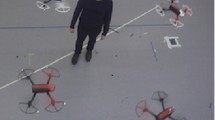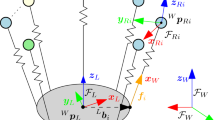Abstract
A new approach to coordination of multiple mobile robots is presented in this paper. The approach relies on the notion of constraint forces which are used in the development of the dynamics of a system of constrained particles with inertia. A familiar class of dynamic, nonholonomic robots are considered. The goal is to design a distributed coordination control algorithm for each robot in the group to achieve, and maintain, a particular formation while ensuring navigation of the group. The theory of constraint forces is used to generate a stable control algorithm for each mobile robot that will achieve, and maintain, a given formation. The advantage of the proposed method is that the formation keeping forces (constraint forces) cancel only those applied forces which act against the constraints. Another feature of the proposed distributed control algorithm is that it allows to add/remove other mobile robots into/from the formation gracefully with simple modifications of the control input. Further, the algorithm is scalable. To corroborate the theoretical approach, simulation results on a group of six robots are shown and discussed.
Similar content being viewed by others
Explore related subjects
Discover the latest articles, news and stories from top researchers in related subjects.References
Chang, D.E., Marsden, J.E.: Gyroscopic forces and collision avoidance with convex obstacles. In: Kang, M.X.W., Borges C. (eds.) New Trends in Nonlinear Dynamics and Control, and their Applications, pp. 145–160. Springer, New York (2003)
Dimarogonas, D.V., Loizou, S.G., Kyriakopoulos, K.J., Zavlanos, M.M.: A feedback stabilization and collision avoidance scheme for multiple independent non-point agents. Automatica 42(2), 229–243 (2006)
Dunbar, W.B., Murray, R.M.: Distributed receding horizon control for multi-vehicle formation stabilization. Automatica 42(4), 549–558 (2006)
Godsil, C., Royle, G.: Algebraic Graph Theory. Springer, New York (2001)
Goldstein, H.: Classical Mechanics. Addison-Wesley, Reading (1953)
Lawton, J.R., Beard, R.W., Young, B.J.: A decentralized approach to formation maneuvers. IEEE Trans. Robot. Autom. 19(6), 933–941 (2003)
Leonard, N.E., Fiorello, E.: Virtual leader, artificial potentials and coordinated control of groups. In: Proceedings of the 40th IEEE Conference on Decision and Control, pp. 2968–2973. IEEE, Piscataway (2001)
Liang, Y., Lee, H.H.: Decentralized formation control and obstacle avoidance for multiple robots with nonholonomic constraints. In: Proceedings of the American Control Conference, pp. 5596–5601, Minneapolis, 14–16 June 2006
Loizou, S.G., Dimarogonas, D.V., Kyriakopoulos, K.J.: Decentralized feedback stabilization of multiple nonholonomic agents. In: Proceedings of IEEE International Conference on Robotics and Automation, New Orleans, 26 April–1 May 2004
Murray, R., Sastry, S.: Nonholonomic motion planning-steering using sinusoids. IEEE Trans. Automat. Control 38, 700–716 (1993)
Ogren, P., Fiorelli, E., Leonard, N.E.: Cooperative control of mobile sensor networks: adaptive gradient climbing in a distributed environment. IEEE Trans. Automat. Control 49(8), 1292–1302 (2004)
Olfati-Saber, R., Murray, R.M.: Distributed cooperative control of multiple vehicle formations using structural potential functions. In: The 15th IFAC World Congress, Barcelona, 21–26 July 2002
Olfati-Saber, R., Murray, R.M.: Distributed structural stabilization and tracking for formations of dynamic multi-agents. In: Proceedings of the 41th IEEE Conference on Decision and Control, pp. 209–215. IEEE, Piscataway (2002)
Pomet, J.B., Thuilot, B., Bastin, G., Campion, G.: A hybrid strategy for the feedback stabilization of nonholonomic mobile robots. In: Proceedings of the 1992 IEEE International Conference on Robotics and Automation, pp. 129–133. IEEE, Piscataway (1992)
Rimon, E., Koditschek, D.E.: Exact robot navigation using artificial potential function. IEEE Trans. Robot. Autom. 8(5), 501–518 (1992)
Stipanovic, D.M., Hokayem, P.F., Spong, M.W., Siljak, D.D.: Cooperative avoidance control for multiagent systems. ASME J. Dyn. Syst. Meas. Control 129, 699–707 (2007)
Tanner, H.G., Jadbabaie, A., Pappas, G.J.: Flocking in teams of nonholonomic agents. In: Morse, N.L.S., Kumar, V. (eds.) Cooperative Control, pp. 229–239. Springer, New York (2004)
Tanner, H.G., Kyriakopoulos, K.J.: Discontinuous backstepping for stabilization of nonholonomic mobile robots. In: Proceedings of the 2002 IEEE International Conference on Robotics and Automation, pp. 3948–3953. IEEE, Piscataway (2002)
Udwadia, F., Kalaba, R.E.: Analytical Dynamics, A New Approach. Cambridge University Press, Cambridge (1996)
Witkin, A., Gleicher, M., Welch, W.: Interactive dynamics. Computer Graph. 24(2), 11–21 (1990)
Yun, X., Yamamoto, Y.: Stability analysis of the internal dynamics of a wheeled mobile robots. J. Robot. Syst. 14(10), 697–709 (1997)
Zou, Y., Pagilla, P.R., Misawa, E.A.: Formation of a group of vehicles with full information using constraint forces. ASME J. Dyn. Syst. Meas. Control 129, 654–661 (2007)
Author information
Authors and Affiliations
Corresponding author
Rights and permissions
About this article
Cite this article
Zou, Y., Pagilla, P.R. Distributed Constraint Force Approach for Coordination of Multiple Mobile Robots. J Intell Robot Syst 56, 5–21 (2009). https://doi.org/10.1007/s10846-009-9314-1
Received:
Accepted:
Published:
Issue Date:
DOI: https://doi.org/10.1007/s10846-009-9314-1




